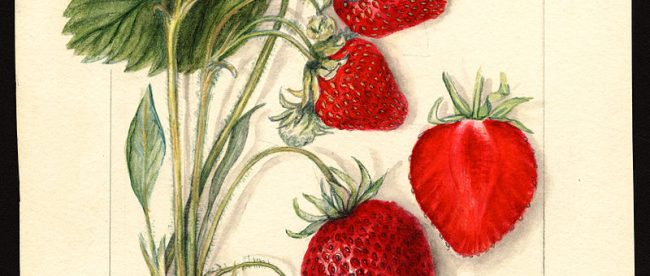Why Did the U.S. Government Pay for a Painting of Strawberries?


Pictured above are three and a half strawberries, the full ones connected to a common stem and adorned with a few leaves. Those strawberries are of the Dunlap variety and, more than a century ago, were grown in the small town of Geneva, New York. The image above is a watercolor painted by an artist named Mary Daisy Arnold; she created this one in 1912. It’s featured on her Wikipedia entry, and by that measure, it’s probably her most famous work. But it’s definitely not her only one — far from it. Over the course of her 35-year career, Arnold created one of more than 1,000 paintings of fruits, nuts, and berries like the one below.
And yes, she made a living this way. Ms. Arnold had a benefactor with deep, deep pocks: the United States government. They paid her — and many others — to paint thousands of pictures of fruit. But it wasn’t art the government was after — it was accuracy.
As the 1800s gave way to the 20th century, the population of the United States grew and spread. The U.S. Department of Agriculture looked for ways to help feed all these people across this growing footprint, and the easiest way to do so was to bring food production to where the people were. That meant more orchards, vineyards, and the like, especially in areas that didn’t have them before. That part proved relatively easy — provided that the climate was appropriate, the USDA could find something to grow wherever you were.
What proved more difficult, though, was educating the new orchardists and others as to what was food, what wasn’t, and what was once edible but is now spoiled or rotten. Today, you’d probably do a Google search and look at a digital image of whatever you were supposed to be growing, but that wasn’t an option in 1912. Neither, for that matter, were photographs, at least not at the scale or quality needed. So instead, the USDA hired artists to paint extraordinarily detailed images like the one above, capturing the likeness of every fruit, nut, and berry grown or sold in the United States. The extensive, decades-long project resulted in what was soon known as the Pomological Watercolor Collection.
For the late 19th and most of the 20th century, these watercolors, per the collection’s website, were “used to create lithographs illustrating USDA bulletins, yearbooks, and other series distributed to growers and gardeners across America.” In total, the collection contained more than 7,500 paintings created by 65 different artists. Some contributed just a few pieces to the collection; others, like Arnold, contributed about 1,000. It was an invaluable resource for the growers, teaching them what was safe and what wasn’t. And, accidentally, all these paintings resulted in a pretty cool art collection as well.
For the latter part of the last century, though, as growers became more sophisticated, the collection was mostly unused. While those studying the history of horticulture found it an invaluable resource, the artistic value of the works went unappreciated by the public, which had little knowledge that it existed. In 2015, a self-described “copyright nerd” named Parker Higgins aimed to undo that, petitioning the government to dedicate the works to the public domain. Their value, he argued, went beyond the fact that they were “remarkable as art,” — they “also have serious scientific importance: they are some of the only documentation, for example, of thousands of apple types that no longer exist.” (And besides, works of art created by an artist as part of his or her official government duties, by default, are typically in public domain anyway.)
Higgins ultimately prevailed. After two years of advocating for the change, as foodie publication Morsel reported, “the USDA ended up making the full digital archive available, high-resolution versions and all.” The entire searchable database can be found here, and Higgins, as an on-going way to share these piece of both art and history, runs a Twitter account which shares a few, randomly, each day.
Bonus fact: Given that the Pomological Watercolor Collection dates back to before women were often employed outside of the home, it may have surprised you that Ms. Arnold, with about 1,000 pieces in the collection, is responsible for about one-sixth of the entire catalog. She’s not unique in that claim, though. Two others — Amanda Newton and Daisy Griscom Passmore — also painted approximately 1,000 pieces each; together, this trio created about half of the works in the database. In fact, approximately two-thirds of the paintings, in total, are by women. This wasn’t because women of the era liked to paint fruit, though; it’s because no one else would hire them. At the time, according to Wikipedia, “working as a government illustrator was one of the few artists’ jobs open to women.”
From the Archives: Esopus Spitzenburg and the Newtown Pippin: A lot of the apples that you’ll find in the database are no longer cultivated, so won’t find these in grocery stores. Here’s why. (But to be clear: you will find them in the database.)
